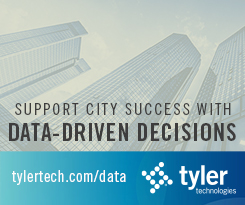
Photo: Poike2017 | Dreamstime.com
Using data to improve public trust
14 July 2022
Sponsored by: Tyler Technologies
During the pandemic, residents turned to their city governments perhaps more than ever as a source of information, help and services. Many local governments rapidly launched COVID-19 dashboards, information hubs and targeted support programmes.
As cities look to recovery, there is much they can learn from this period about demonstrating transparency and building trust with data.
When the pandemic took hold in 2020, Buffalo in New York launched a two-pronged approach, involving a public hub for COVID-19 response resources, as well as internal dashboards to support commissioners and executive-level staff for decision-making.
“One of the issues the city has faced, health care providers have faced, and emergency first responders have faced, is misinformation that has been presented as fact,” Buffalo Mayor Byron Brown said at the time. “It’s critically important that people get good information, accurate information, so they can make the proper health care decisions for themselves that have an impact not only on their health, but their family members and their friends.”
Local picture
The city selected Tyler Technologies’ Data & Insights solution. By April 2020, the city had launched the Enterprise Data Platform – Tyler’s enterprise scale, FedRAMP-certified, internal data-sharing platform – as well as Tyler’s Open Data Platform.

While staff could analyse and securely share data without needing to rely on a network connection, the public had quick access to a wide range of information such as health and mental health resources; assistance for small businesses and people looking for work; details on free meals; information on homeless shelters; and access to virtual events.
Kirk McLean, Director of Open Data and Chief of Staff to the city’s CIO, said: “Having easily consumable data and visualisations can go a long way in helping people understand what’s happening.”
Buffalo was an early adopter of this approach and many cities across the US followed.
“I think this was a big win for cities,” says Melissa Bridges, who joined Tyler Technologies as Senior Client Success Manager last year, having previously worked for ten years for the City of Little Rock. “Local leaders were able to share local context and build trust through that.”
Funding
Many cities are now building on this to keep dialogue going with their residents – particularly as historic federal funding flows to communities through the US$1.9 trillion American Rescue Plan Act and US$1.2 trillion Bipartisan Infrastructure Law.
“Cities now want to show how these funds are being allocated, where they’re being spent, and the impact they’re having in the community,” said Bridges. “I think that’s the next step in using this to build trust and we’re starting to see more and more of those dashboards around.”
Through this cities can show residents how the money is being used to address the issues that matter to them, such as supporting small businesses, expanding broadband internet access, or increasing affordable housing.
Pierce County in Washington used Tyler’s Enterprise Data Platform, which it has had in place since 2018, to track its CARES Act allocation of US$158 million. The platform integrates data sources across the county for a comprehensive view and leaders used insights to understand the impact of programmes and pivot as necessary. The technology also provided county staff with the capability to publish data publicly, giving residents, businessowners, and others the ability to see progress on the recovery effort for themselves and dive into source data if they wanted to.
Pierce County has now built a data tracker for its US$176 million American Rescue Plan Act allocation.
During a recent webinar held by the Pandemic Response Accountability Committee, Julie Demuth, assistant director of budget and performance for Pierce County, Washington, said: “How we communicate data is essential. Communication is probably even more important than the data itself. You can put a ton of data out there and make it available to the public but if it’s not consumable or understandable, it really defeats the purpose.”
Another emerging example of using data to bolster trust is tracking racial disparities in policing. Using dashboards to outline climate goals, actions and progress is also likely to become a growing trend.
Transparency
Transparency is critical when sharing data with the public, and this means also being open about gaps and potential errors.
“Data is rarely perfect because there are humans involved,” said Bridges.
She urged cities to create mechanisms for two-way feedback with residents on data.
The state of Washington, for example, partnered with the Washington State Library to create policies around cataloguing, adding, and removing data from the open data portal. This partnership resulted in a public-facing document that explains the policies so users can trust the collection and removal standards are fair and meet community needs.
Bridges said a lot of cities are now building relationships further by using data to tell a story.
“It’s not just publishing datasets and creating charts and graphs,” she commented. “The next step to make sure that data is actually used and understood is the story that gets wrapped around it.”












